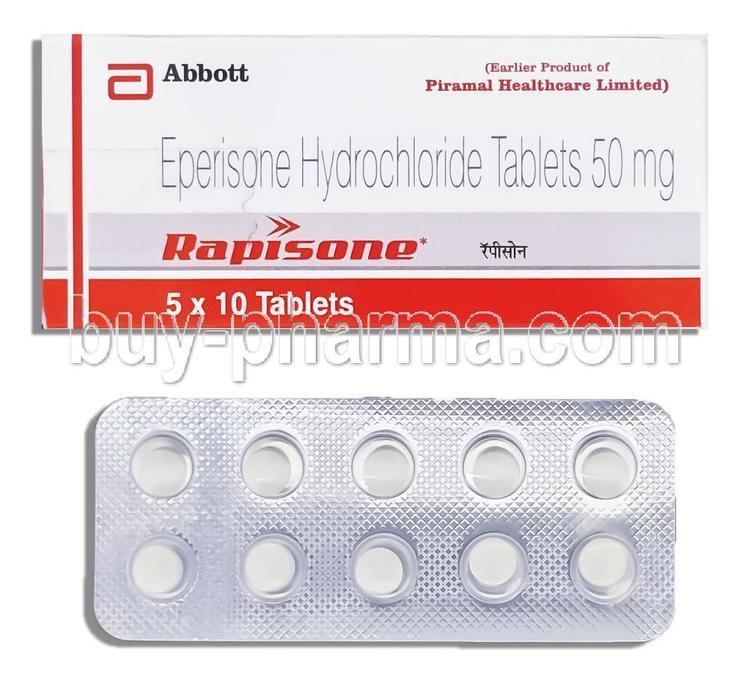Routes ofadministration O Legal status not licensed PubChem CID 3236 CAS ID 56839-43-1 | ATC code M03BX09 (WHO) CAS Number 56839-43-1 Molar mass 259.387 g/mol | |
 | ||
AHFS/Drugs.com International Drug Names | ||
How to pronounce eperisone
Eperisone (formulated as the eperisone hydrochloride salt) is an antispasmodic drug.
Contents
- How to pronounce eperisone
- Indications
- Presentation
- Dosage and administration
- Safety during pregnancy and breast feeding
- Pharmacology
- Contraindications
- Cautions
- Side effects
- Drug interactions
- Safety in overdose
- Future developments
- Brand names
- References
Eperisone acts by relaxing both skeletal muscles and vascular smooth muscles, and demonstrates a variety of effects such as reduction of myotonia, improvement of circulation, and suppression of the pain reflex. The drug inhibits the vicious circle of myotonia by decreasing pain, ischaemia, and hypertonia in skeletal muscles, thus alleviating stiffness and spasticity, and facilitating muscle movement
Eperisone also improves dizziness and tinnitus associated with cerebrovascular disorders or cervical spondylosis.
Eperisone has a relatively low incidence of sedation when compared with other antispasmodic drugs; this simplifies the clinical application of the drug and makes it an attractive choice for patients who require antispasmodic therapy without a reduction in alertness.
Eperisone also facilitates voluntary movement of the upper and lower extremities without reducing muscle power; it is therefore useful during the initial stage of rehabilitation and as a supporting drug during subsequent rehabilitative therapy.
Indications
Presentation
Eperisone hydrochloride is available as the brand name preparation Myonal as 50 mg sugar coated tablets, or as 10% granules for oral administration. An experimental form of the drug, as a transdermal patch system, has shown promising results in laboratory tests on rodents; however, this product is not currently available for human use. It is also available as the brand name Epry as 50 mg as sugar coated tablets.
Dosage and administration
In adults, the usual dose of eperisone is 50–150 mg per day, in divided doses, after meals. However, the dosage is adjusted by the prescribing clinician depending on factors such as severity of symptoms, patient age and response.
Eperisone has not been established as definitely safe for paediatric use, therefore its use in paediatrics cannot be recommended without further study.
If elderly patients are treated with eperisone, a reduced dose is recommended, and the patient should be closely monitored for signs of psychological hypofunction during treatment.
Safety during pregnancy and breast-feeding
Eperisone has not been established to be safe for use by pregnant women; therefore the drug should only be used in pregnant women, or women who may be pregnant, if the expected therapeutic benefits will outweigh the possible risks associated with treatment. The manufacturers of Myonal recommend the drug not be used during lactation (breast-feeding). If eperisone must be used, the patient is advised to stop breast-feeding for the duration of treatment. Eperisone has beed reported to be excreted in breast milk in an animal study (in rats).
Pharmacology
Contraindications
Eperisone is contraindicated in patients with known hypersensitivity to the drug. Side effects: 'very rare' excessive relaxation, stomachache, nausea, vertigo, anorexia, drowsiness, skin rashes, diarrhoea, vomiting, indigestion, GI disturbances, insomnia, headache, constipation etc.
Cautions
Eperisone should be administered with care in patients with a history of hypersensitivity to any medication, or with disorders of liver function (it may aggravate hepatic dysfunction).
Weakness, light-headedness, sleepiness or other symptoms may occur. In the event of such symptoms, the dosage should be reduced or treatment discontinued. Patients should be cautioned against engaging in potentially hazardous activities requiring alertness, such as operating machinery or driving a car.
Side effects
Drug interactions
There have been reports of disturbances in ocular accommodation occurring after the concomitant use of the related drug tolperisone hydrochloride and methocarbamol.
Safety in overdose
Seizures have been reported in an infant after accidental ingestion of eperisone.
Future developments
Eperisone suffers from a very low bioavailability when taken orally, as a result of high first pass intestinal metabolism; a transdermal patch containing eperisone is currently in development in South Korea. This has shown promise, with the antispasmodic effect lasting over 24 hours, compared to one to two hours following oral administration.
Eperisone is also under investigation as an antihypertensive agent, with promising results from trials on beagles.
Brand names
Eperisone is marketed under many brand names worldwide.
